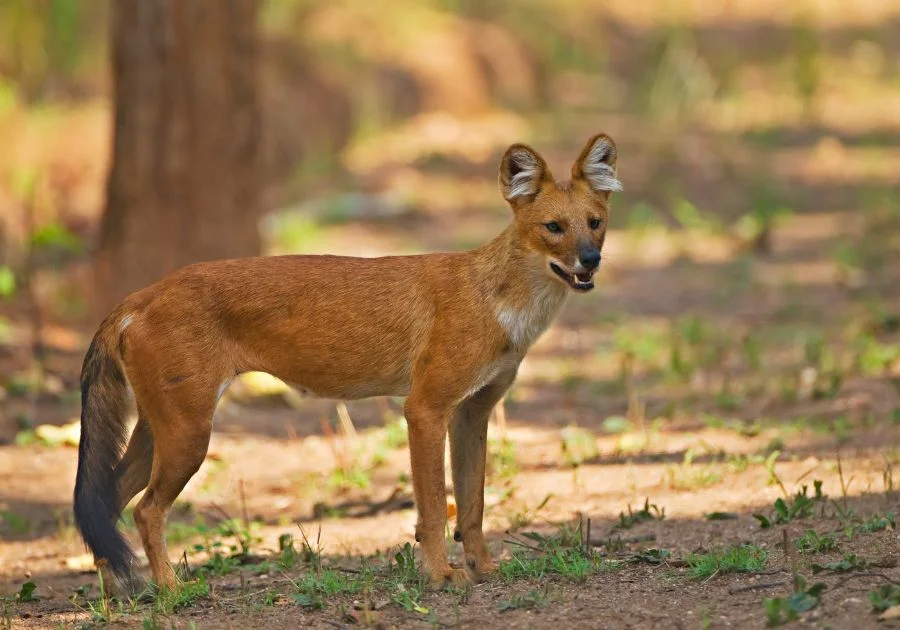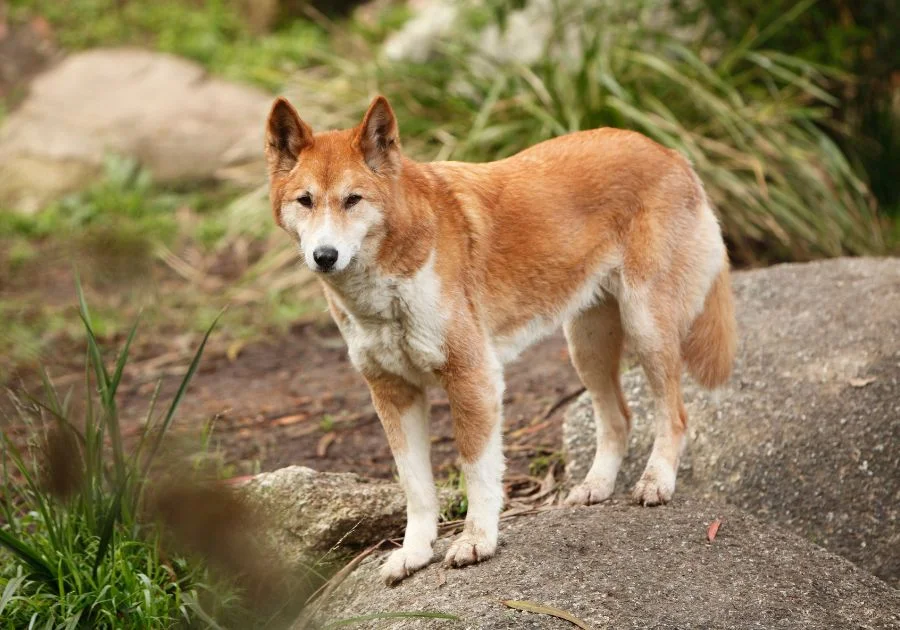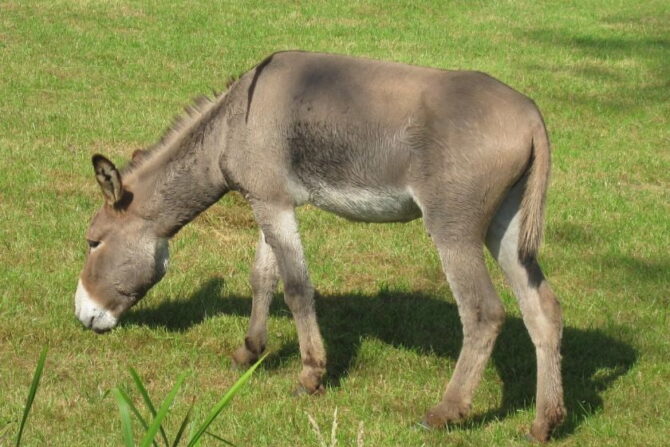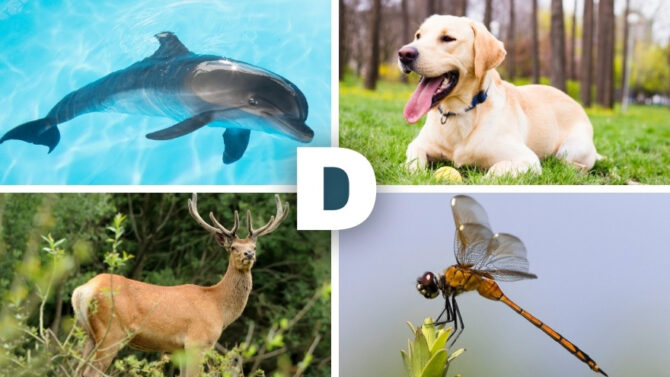When it comes to the animal kingdom, countless species inhabit our planet, each with its own unique characteristics and traits.
Some of these animals are well-known and commonly discussed, while others are more obscure and lesser known.
In this article, we will explore some of the animals that start with D. From tiny insects to massive mammals, a diverse range of creatures fit into this category.
Join us as we delve into the fascinating world of letter D animals and discover some of the amazing creatures that call our planet home.
Alphabetical List of Animals that Start with D
Daeodon
Unlike the pink cuties with curly tails, Dadedon is a prehistoric pig with masculine characteristics.
This animal was first found and lived in the Oligocene and Miocene epochs more than 20 million years ago.
Daeodons are much bigger than the regular pig species you see today, and they aren’t related to them in any way.
Fun Fact: Scientists wish to study the daeodon but don’t know if it has scales, feathers, or fur.
Dalmatian
The white and black spots on this dog’s coat make it an easily recognized breed.
It is highly popular for its sensitive temperament and energy level and for belonging to the non-sporting group.
The name “Dalmatian” was gotten from a coastal area in Austria called Dalmatia.
Fun Fact: The dalmatian is a playful and energetic dog!
Dark-Eyed Junco
This animal is from the sparrow family and looks much like sparrows.
The Dark-eyed Junco is also known as a “snowbird” in the United States.
Although they are smaller than most sparrows, the resemblance is clear. They have a diverse range of colors and possess a long list of subspecies found in various regions.
Fun Fact: The name “snowbird” came about when people found out that many subspecies reappear in the winter.
Darwin’s Fox
Only a few numbers of Darwin’s foxes live in our current world. The first inhabits an island off the coast of Chile, while the other lives in several parts of the mainland.
This fox lives a rather secretive life in the temperate forests of these places and is known as one of the world’s littlest foxes.
Fun Fact: The Darwin’s fox isn’t a true fox.
Darwin’s Frog
You’d mistake this animal for a regular frog species, but they are quite different.
Darwin’s frogs were first discovered by Charles Darwin in his “Voyage of the beagle.”
Usually located in the woods in Chile and Argentina, these animals are rarely spotted, even when right in front of them.
Their body color makes it difficult to find them. People mistake them for dried leaves.
Fun Fact: Young Darwin’s frogs stay in their vocal sacs for 50 to 70 days.
De Kay’s Brown Snake
This is a rare snake species inhabiting the eastern half of North America and Central America.
Although this animal is nonvenomous and docile, it still huddles beneath the ground or otherwise in shady locations.
It is a snail- and slug-eating snake that loves to spend most of its time in moist areas, close to its prey.
Fun Fact: The jaws of de kay’s brown snakes are naturally specialized for removing snails from shells.
Death Adder
Like Papua New Guinea, this snake is native to eastern and southern Australia. This species detests desert areas. They prefer the woods and grassy spaces.
Fun Fact: The death adder is also called the “common death adder” and is more closely related to the cobra than other Australian snakes.
Decorator Crab
Known as the most ingenious disguise artists, decorator crabs are small to medium-sized animals belonging to the superfamily Majoidea.
A few individuals call them “spider crabs.” They are rampant all over the world, with approximately 75% of the species in the family decorating their shells with plants and animals. They do this to ward off predators.
Fun Fact: Old decorations are recycled when decorators mothball them.
Deer

Always coping with and adapting to the rigors of a hostile world, the deer is one of the most popular animals and a common sight in many parts of the world.
It inhabits forests and plains and has proliferated across the globe such that it easily adapts to any ecosystem.
Its regal antlers are a distinct trait that many find interesting.
Fun Fact: There are about 40 different deer species.
Devil’s Coach Horse Beetle
This is a dangerous beetle species. The name is a result of its ancient traces and how evil people considered it to be.
Some people believe this animal is capable of inflicting a curse on someone whenever its tail points in that person’s direction.
This superstition is a result of their painful bite.
Fun Fact: The devil’s Coach horse beetle releases a foul gas to repel and protect itself against predators.
Desert Locust
With the grasshopper’s appearance, this animal possesses hindlegs and compound eyes.
Their travel speed in a swarm is estimated at 21 miles per hour. Desert locusts tend to congregate in swarms of about 80 million individuals.
They have good hunting skills when it comes to hunting for food and can raid an entire grain field in a few hours.
Fun Fact: Their color changes during a gathering and ranges from bright yellow to neutral shades.
Deathwatch Beetle
These are small insects with similar traits to other nettle species. They make distinctive tapping sounds, which many consider an omen of death.
Thanks to the research made by animal specialists, we know that deathwatch beetles tap on wood as some kind of mating ritual.
The male makes a tapping noise continuously, and the female traces the sound in the direction of the male.
Fun Fact: The adult deathwatch beetle only lives for two months.
Death-head’s Cockroach
This insect gets its name from the black markings on its thorax and serves as a pet for many animal lovers.
Death Head’s cockroaches originate from the Caribbean, Central America, and Mexico.
Although they have a similar appearance to the regular cockroach species, death-head cockroaches can get up to 2 inches long.
Fun Fact: The death head’s cockroach can live up to a year, unlike other species.
Dhole

Dholes are wild dogs and may be uncommon to the general public. These animals look like a cross between a gray wolf and a red fox.
They used to be widespread but can only be found in parts of Asia in recent times.
Fun Fact: An adult dhole gorges itself on meat with the purpose of regurgitating it to feed members of the pack.
Dingo

Native to Australia, dingos are wild dogs with intuitive hunting skills. Their pack mentality and hunting style is similar to those of wolves.
Fun Fact: Only the alpha male is eligible to mate with female dingos in a pack.
Dog

Dogs are highly social animals that have been domesticated for thousands of years.
They are beloved pets and have been trained for various tasks and activities. With hundreds of different breeds, they are known for their loyalty, affection, and ability to form strong bonds with their owners.
Despite their domestication, they still retain many wild instincts and behaviors. Dogs bring joy and companionship to countless people around the world.
Fun Fact: Did you know that dogs have a sense of smell up to 100,000 times better than humans? Their sense of smell is so keen that they are often used in law enforcement to detect drugs, explosives, and even cancer!
Donkey

Donkeys are animals with ancient traces and a good reputation to date.
They are also widespread across continents and serve as a useful means of transportation for some people. A donkey can be seen in almost all parts of the world.
These animals easily bond with themselves and other farm animals and have been domesticated for more than 5000 years.
They were known as “asses” until the word slowly fell out of use.
Fun Fact: Separating a bonded donkey can lead to death.
Dolphins
These are sea mammals, playful and more intelligent than you can ever imagine.
Dolphins have similar traits to fish but possess more abilities and have always been humans’ favorites.
As playful as they may seem, dolphins are also delicate and should be petted with caution.
Their smarts are above par, such that they have been trained to help humans even as early as the 1960s.
Fun Fact: Dolphins’ brains are larger than those of humans.
Dove
Doves are a type of small to a medium-sized bird that are found all over the world. They are known for their gentle cooing and soft, graceful flight.
Doves are often used as symbols of love and peace, and they are a common sight at weddings and other ceremonies.
They mate for life and are known for their strong pair bonds, which can last for many years.
Fun Fact: Doves have a unique ability to navigate using the earth’s magnetic field. Scientists believe that doves use tiny magnetic particles in their beaks to sense the earth’s magnetic field and navigate during migration.
Draco Volan Lizard
Draco Volans is a substitute name for “flying dragon.” As surprising as it may seem, this animal doesn’t really fly. It glides instead.
The Draco Volan Lizard has a winglike membrane supported by its ribs and spends most of its days in trees. The males are usually territorial.
Fun Fact: The draco volan lizard can glide for about 26 feet.
Dragonfish
These are scary fish. The name “dragonfish” is derived from its dangerous and unappealing physical appearance.
Broad jaws, terrifying teeth, and large heads are distinct characteristics of this animal.
These animals are usually large, with males being nearly ten times the size of females. Only a few species have scales.
Fun Fact: The dragonfish uses the red chlorophyll in its eyes to attract unsuspecting prey.
Dragonfly
Dragonflies are fascinating insects often found near bodies of water, such as lakes, ponds, and rivers.
They have slender bodies, long wings, and large compound eyes, which help them to fly quickly and catch prey.
One of the most remarkable things about dragonflies is their incredible agility and speed. They are able to fly in any direction, change direction quickly, and even hover in place.
They can fly at speeds of up to 45 miles per hour, making them one of the fastest insects in the world.
Fun Fact: Dragonflies have been around for over 300 million years, and they are one of the oldest insects in the world.
Drumfish
Drumfish are purely aquatic animals that are usually located in the bottom part of the sea.
Some species live in freshwater, but most drumfish like saltwater. The latter is widespread and has a higher number of species compared to the former.
These fish will swim through the depths of the lake just to find food. They feed on crustaceans, fish, and inside along this sea level.
Fun Fact: The drumfish make a loud noise with their swim bladders, which is also how they get their names.
Ducks
Ducks are aquatic birds that are found all over the world, from ponds and lakes to oceans and rivers.
They have webbed feet and waterproof feathers, which make them well-suited to swimming and diving for food.
One of the most interesting things about ducks is their wide range of vocalizations.
They are known for their quacking sound, but they also make various other noises, including whistles, grunts, and even soft purring sounds.
Fun Fact: Ducks have a specialized type of feathers called “down feathers” that help them to stay warm in cold water.
Dung Beetle
Also known as the scarab, this small animal is popular for its penchant for rolling feces from one point to another.
Their distinct back cover body is the reason why they’ll always be outstanding among other insects.
Dung beetles are selective when it comes to the food they eat. They tend to be picky and will not just eat any random pile of feces.
Fun Fact: The dung beetle animals might be capable of orienting themselves using the stars of the Milky Way.
Conclusion
We have explored a variety of animals that start with D. From the majestic dolphin to the diminutive damselfly; these creatures demonstrate the incredible diversity of life on our planet.
Each of these animals has its own unique characteristics and plays an important role in their respective ecosystems.
It is a reminder of the beauty and complexity of the natural world and the need to protect and preserve these incredible creatures for future generations to enjoy.






